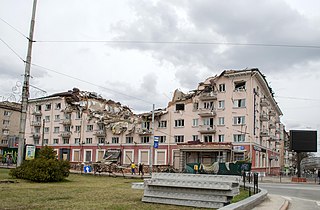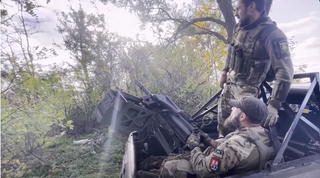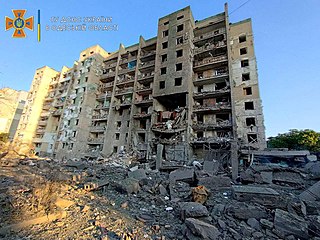
The siege of Chernihiv was a military engagement in the city of Chernihiv, in Chernihiv Oblast in the north of Ukraine. It began on 24 February 2022, as part of the northern Ukraine offensive, during the 2022 Russian invasion of Ukraine. On 4 April 2022, Ukrainian authorities stated that the Russian military had left Chernihiv Oblast.

On 3 March 2022, 47 people were killed in a series of airstrikes in Chernihiv by Russian forces during the siege of the city, during the 2022 Russian invasion of Ukraine. Amnesty International and Human Rights Watch described the strikes as a war crime.

On 16 March 2022, a Russian attack killed at least 18 and injured 26 civilians in Chernihiv, Ukraine, who were waiting in a line for bread.

During the southern Ukraine offensive of the Russian invasion of Ukraine, the city of Odesa and the surrounding region have been the target of shelling and air strikes by Russian forces on multiple occasions since the conflict began, fired predominantly from Russian warships situated offshore in the Black Sea. The city has also been targeted by Russian cruise missiles.

There have been attacks in mainland Russia as a result of the Russian invasion of Ukraine, which began on 24 February 2022. The main targets have been the military, the arms industry and the oil industry. Many of the attacks have been drone strikes, firebombing, and rail sabotage. The Ukrainian intelligence services have acknowledged carrying out some of these attacks. Others have been carried out by anti-war activists in Russia. There has also been cross-border shelling, missile strikes and ground raids from Ukraine, mainly in the Belgorod, Kursk and Bryansk oblasts. Several times, Ukrainian-backed armed groups have launched incursions from Ukraine into Russia, captured border villages and battled the Russian military. While Ukraine has supported these ground incursions, it has denied direct involvement.
A series of border skirmishes has taken place along the Russia–Ukraine border in Sumy and Chernihiv Oblasts since the withdrawal of Russian troops from Northern Ukraine. Ukrainian officials have stated that strikes across the border happen daily.

The battle of Huliaipole is an ongoing military conflict between the Armed Forces of Russia and the Armed Forces of Ukraine over the city of Huliaipole, in central Zaporizhzhia Oblast.

On 1 July 2022, at 01:00 am (UTC+3), a Russian missile hit a residential building and two missiles hit a recreational center in Serhiivka, Bilhorod-Dnistrovskyi Raion, Odesa Oblast. The missile strike killed at least 21 people. July 2 was declared a day of mourning in the region.

During the 2022 Russian invasion of Ukraine, the Russian Armed Forces have launched several missile attacks over the city of Dnipro in Ukraine. These have led to dozens of fatalities and over a hundred injuries among the civilian population.

The 2022–present bombing of Lviv and the Lviv Oblast began after the Russian invasion of Ukraine. Lviv Oblast was attacked from March–November, and Lviv city from May–October 2022. The targets were both civilian and military, including electricity and railway infrastructure and a military base. Seven civilians were killed.

During the Russian invasion of Ukraine, the Russian military have carried out deliberate attacks against civilian targets and indiscriminate attacks in densely-populated areas. The United Nations Human Rights Monitoring Mission in Ukraine says the Russian military exposed the civilian population to unnecessary and disproportionate harm by using cluster bombs and by firing other weapons with wide-area effects into civilian areas, such as missiles, heavy artillery shells and multiple launch rockets. As of 2024, the attacks had resulted in the UN-documented deaths of between 11,000 and estimated 40,000 dead civilians. On 22 April 2022, the UN reported that of the 2,343 civilian casualties it had been able to document, it could confirm 92.3% of these deaths were as a result of the actions of the Russian armed forces.

During the autumn and winter of 2022–2023, Russia launched waves of missile and drone strikes against energy in Ukraine as part of its invasion. The strikes targeted civilian areas beyond the battlefield, particularly critical power infrastructure, which is considered a war crime. By the end of 2023, Russian forces launched about 7,400 missiles and 3,900 Shahed drone strikes against Ukraine according to Ukrainian military officials.

Aerial warfare in the Russian invasion of Ukraine began at dawn of 24 February 2022, with infantry divisions and armored and air support in Eastern Ukraine, and dozens of missile attacks across Ukraine. The first fighting took place in Luhansk Oblast near the village of Milove on the border with Russia at 3:40 am Kyiv time. The main infantry and tank attacks were launched in four spearhead incursions, creating a northern front launched towards Kyiv, a southern front originating in Crimea, a south-eastern front launched at the cities of Luhansk and Donbas, and an eastern front. Dozens of missile strikes across Ukraine also reached as far west as Lviv. Drones have also been a critical part of the invasion, particularly in regards to combined arms warfare. Drones have additionally been employed by Russia in striking Ukrainian critical infrastructure, and have been used by Ukraine to strike military infrastructure in Russian territory.
This timeline of the Russian invasion of Ukraine covers the period from 8 June 2023, when the 2023 Ukrainian counteroffensive began, to 31 August 2023.

In the early morning hours of 29 December 2023, Russia launched what was seen to be the largest wave of missiles and drones yet seen in the Russo-Ukrainian War, with hundreds of missiles and drones hitting the Ukrainian capital Kyiv and other cities across the country. At least 58 people were reported to have been killed in the attacks, while 160 others were injured.
This timeline of the Russian invasion of Ukraine covers the period from 1 December 2023 to 31 March 2024.
On 30 December 2023, during the ongoing Russian invasion of Ukraine, explosions occurred in the city of Belgorod, Russia, killing at least 25 people and wounding over 100. Russian sources alleged the explosions were shelling by the Ukrainian Armed Forces. Ukraine attributed the explosions to the work of Russian air defence.
The Russian Armed Forces have launched several rocket attacks on Chernihiv, Ukraine, during the Russian invasion of Ukraine.
This timeline of the Russian invasion of Ukraine covers the period from 1 April 2024 to the present day.

Air strikes on Kharkiv were carried out by the Russian Armed Forces in four locations on 25 May 2024. At least one UMPB D-30SN bomb was dropped at an Epicentr K hypermarket, destroying it. Russian forces dropped another bomb on the central park of culture and recreation, but it did not detonate. In the evening, Russian forces hit a street in a dense residential area of the city. At least two of the victims killed in the airstrike were Epicentr store employees.













